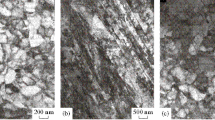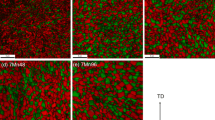Conclusions
-
1.
Statistical relationships were obtained between the yield strength and ductile—brittle transition temperature and the grain size of ferrite in commercial structural steels differing in strength.
-
2.
The use of an equation of the Hall-Petch type makes it possible to calculate the effect of individual hardening mechanisms on the yield strength of steels.
-
3.
The variation of the ductile—brittle temperature with grain size is satisfactorily described by equations of the type 1/Tcr=A+Blnd−1/2 and Tcr=M−Nlnd−1/2, derived from the Cottrell-Petch transition criterion (transition to brittle fracture).
-
4.
A formal analysis leads one to expect a reduction of the cold resistance of ferrite with refining of the subgrains. The existing experimental data do not contradict this assumption.
-
5.
The difference in the cold resistance of carbon steel differing in degree of deoxidation but with the same grain size is largest for coarse-grained steels and smallest for fine-grained steels. The cold resistance is associated with the substructure, which is more highly developed in the steel deoxidized to a lesser extent.
-
6.
The increasing cold resistance as one passes from carbon steel to low-alloy steel to high-strength steel is due to grain refining of ferrite. With the same grain size, carbon steel is not inferior to low-alloy steel in its cold resistance and may even be superior due to its lower strength.
Similar content being viewed by others
Literature cited
F. Pickering and T. Gladman, Iron and Steel Institute, Special Report No. 81 (1963), pp. 19–29.
A. Cottrell, Trans. AIME,212, 129 (1958).
A. H. Cottrell, “Theoretical aspects of the process of fracture,” in: Atomic Mechanism of Failure [Russian translation], Metallurgiya, Moscow (1963), pp. 30–58.
N. D. Petch, “Transition from ductile to brittle condition in α iron,” in: Atomic Mechanism of Failure [Russian translation], Metallurgizdat, Moscow (1963), pp. 69–80.
K. Ikeda, J. Akita, and H. Kihara, Welding J., 3, 133 (1967).
A. Stroh, Advan. Phys., 6, 418 (1957).
F. Kazinchi, U. Bekofen, and B. Kapadia, Discussion with N. D. Petch in: Atomic Mechanism of Failure [Russian translation], Metallurgizdat, Moscow (1963), pp. 81–83.
A. Kochendorfer and H. Shrainer, “Effect of grain size and stress on transition temperatures of steel,” Chernye Metally, 19, 21–31 (1969).
G. Langford and M. Cohen, Trans. ASM,62, 623 (1969).
D. Smith and R. Heheman, J. Iron Steel Inst.,209, 6, 476–481 (1971).
J. Danko and R. Stent, Trans. ASM,49, 189 (1957).
J. Wegrzyn, J. Hutnik,32, 83 (1965).
A. P. Gulyaev and V. N. Nikitin, “Comparison of different methods of calculating resistance of steels to brittle fracture,” Zavod. Lab.,31, 1, 88–94 (1965).
W. Jolley and E. Kottcamp, Trans. ASM,59, 439–456 (1966).
M. I. Gol'dshtein, G. N. Elokhina, and É. L. Kolosova, “Fine structure of excess ferrite with diffusion decomposition of austenite,” Metal. i Term. Obrabotka Metal., 8, 14–16 (1973).
G. A. Vorob'eva et al., “Variation of some physical properties of steel 40Kh with deoxidation procedure,” Metal. i Term. Obrabotka Metal., 5, 36–40 (1973).
M. V. Pridantsev et al., “Heat treatment of steel St3kp for buildings,” Stal', 5, 449–456 (1958).
Additional information
TsNIIPROEKTSTAL'KONSTRUKTsIYa. Translated from Metallovedenie i Termicheskaya Obrabotka Metallov, No. 2, pp. 16–22, February, 1975.
Rights and permissions
About this article
Cite this article
Gladshtein, L.I. Statistical relationship between the mechanical properties and grain size of structural steels. Met Sci Heat Treat 17, 113–118 (1975). https://doi.org/10.1007/BF00679160
Issue Date:
DOI: https://doi.org/10.1007/BF00679160




